For cat owners seeking the best nutrition for their feline friends, understanding the nuances of different food types is crucial. Hydrolyzed protein wet cat food has emerged as a popular choice, particularly for cats with sensitive stomachs or allergies. But what exactly is it, and is it the right option for your cat? This comprehensive guide will explore the ins and outs of hydrolyzed protein wet cat food, addressing common questions and concerns.
What is Hydrolyzed Protein in Cat Food?
Hydrolyzed protein is protein that has been broken down into smaller peptides and amino acids. This process, called hydrolysis, makes the protein easier to digest. Think of it as pre-digesting the protein for your cat, reducing the strain on their digestive system. This is particularly beneficial for cats with food sensitivities or allergies because the smaller protein fragments are less likely to trigger an immune response. Instead of whole proteins which can be recognized as allergens, the smaller pieces are less likely to cause a reaction. This makes it a valuable option for managing food allergies and intolerances.
What are the Benefits of Hydrolyzed Protein Wet Cat Food?
-
Improved Digestion: The smaller size of the protein molecules makes digestion significantly easier, reducing digestive upset, gas, and diarrhea. This is especially helpful for cats with sensitive digestive systems or inflammatory bowel disease (IBD).
-
Allergy Management: Because the proteins are broken down into smaller, less recognizable pieces, hydrolyzed protein diets can be effective in managing food allergies and intolerances. This is a crucial aspect for cats experiencing persistent skin issues, itching, or digestive problems linked to food allergies.
-
Enhanced Nutrient Absorption: Better digestion often leads to improved nutrient absorption, ensuring your cat receives the full nutritional benefits of the food. This translates to healthier skin and coat, increased energy levels, and a stronger immune system.
-
Reduced Inflammatory Response: By minimizing the chances of an allergic reaction, hydrolyzed protein helps to reduce inflammation in the body, further contributing to improved overall health.
What are the Potential Risks of Hydrolyzed Protein Wet Cat Food?
While generally safe and beneficial, some potential drawbacks exist:
-
Cost: Hydrolyzed protein cat food is typically more expensive than standard cat food due to the specialized manufacturing process.
-
Palatability: Some cats may be less inclined to eat hydrolyzed protein food due to its different taste and texture. Introducing it gradually is crucial for acceptance.
-
Nutrient Deficiency (Rare): While less common with reputable brands, there's a potential for nutrient deficiencies if the food isn't properly formulated. Always choose high-quality, veterinarian-recommended brands.
Is Hydrolyzed Protein Wet Cat Food Right for My Cat?
Whether hydrolyzed protein wet cat food is suitable for your cat depends on its individual needs. It's essential to consult your veterinarian. They can perform tests to determine if your cat has food allergies or intolerances and recommend the most appropriate diet. This is particularly important if your cat is exhibiting symptoms such as chronic digestive issues, skin problems, or recurrent ear infections.
How Do I Choose a Good Quality Hydrolyzed Protein Wet Cat Food?
Choosing a high-quality product is paramount. Look for food that:
- Is specifically formulated for cats: Avoid products designed for dogs or other animals.
- Lists hydrolyzed protein as the primary ingredient: This ensures a sufficient amount of hydrolyzed protein for effectiveness.
- Has a complete and balanced nutritional profile: Check for the Association of American Feed Control Officials (AAFCO) statement to confirm it meets the nutritional needs of adult cats.
- Is from a reputable brand: Choose established brands with a history of quality and safety.
What are the Differences Between Hydrolyzed and Novel Protein Cat Food?
Both hydrolyzed and novel protein cat foods aim to manage allergies, but they do so differently. Hydrolyzed protein breaks down existing proteins, while novel protein uses proteins your cat hasn't been exposed to before, such as kangaroo or venison. The best option depends on your cat's specific allergy and your veterinarian's recommendation.
Can I Switch My Cat to Hydrolyzed Protein Wet Cat Food Suddenly?
No, it is crucial to transition your cat gradually to a new diet, including hydrolyzed protein. Sudden changes can upset their digestive system. Mix small amounts of the new food with their current food over several days, gradually increasing the proportion of the new food until they are eating it exclusively.
How Long Does it Take to See Improvement with Hydrolyzed Protein Cat Food?
The timeframe for seeing improvement varies among cats. Some may show noticeable improvements within a few weeks, while others might take longer. Consistent feeding and monitoring are essential. Regular check-ups with your veterinarian are crucial to track progress and make adjustments as needed.
By carefully considering these factors and consulting your veterinarian, you can make an informed decision about whether hydrolyzed protein wet cat food is the right choice for your beloved feline companion. Remember, prioritizing your cat's health and well-being is always the top priority.
